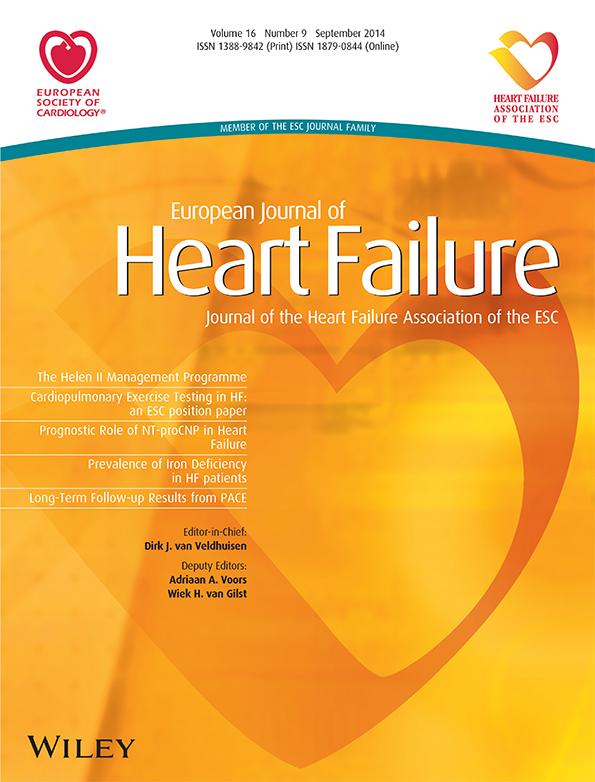The global relevance of disease management programmes for heart failure
Heart failure is a worldwide health-care problem, recently highlighted in a report from the Global Heart Failure Awareness Programme of the Heart Failure Association of the European Society of Cardiology.1 For nearly all countries for which there are data, heart failure consumes 1–2% of expenditure, chiefly related to the costs of hospitalization. Despite differences in heart failure aetiology and demographics in high- and middle-income countries, the need for accurate and speedy diagnosis, access to life-saving therapies, and appropriate support for individuals and their families is universal. International guidelines strongly support disease management programmes,2, 3 including follow-up shortly after discharge from hospital and in the high-risk period (the first 3 months) thereafter. The most recent edition of the American College of Cardiology/American Heart Association guidelines suggest that a follow-up visit within 7–14 days and/or a telephone follow-up within 3 days of hospital discharge are ‘reasonable’, with a B grading for level of evidence and a IIa class of recommendation. Standards have also been suggested for disease management programmes, with the goal of providing a seamless system of care across primary and hospital care.4 Patient education to support self-monitoring and self-care, where appropriate, is seen as central to any such programme.
However, the evidence base for such recommendations is largely confined to randomized trials from high-income countries. In a recent meta-analysis of disease management programmes for heart failure, including 46 studies,5 30 (65%) were based in the USA or Canada, nine in Europe, six in Australia or New Zealand, and only one came from a middle-income country (Argentina).
Despite international guidelines, the relevance of a randomized clinical trial (RCT) to routine practice is often questioned. This is particularly the case when the RCT is based in a health-care system that is constructed (and funded) in a very different way from that found in the geography considering how to organize heart failure services. Reimbursement authorities and health-care insurance companies frequently question the relevance of studies from other geographies. Of course, the biology of the heart failure is unlikely to be different, but the impact of a health-care intervention on the pattern of health-care utilization may be very different. Where the quality or relevance of the evidence is questioned, partial or no implementation is the likely scenario.
De Souza and colleagues6 should be congratulated on performing a high-quality randomized controlled trial of a nurse-based home intervention, with telephone reinforcement, in the Brazilian health-care system, where many patients often do not have systematic follow-up after discharge from hospital for a variety of reasons, including cost.
The HELEN II programme consisted of up to four home visits of an hour's duration after discharge from hospital. The first occurred within 10 days of discharge (in keeping with the most recent North American guidelines), and then at 1 month, 2 months, and 4 months after discharge. In addition, there were telephone calls during the programme (four calls of around 10 min) to reinforce the recommendations made during the home visits, to check the use of prescribed medication, and to answer questions about the condition and its treatment. Owing to restrictions on time and staff, only patients living within 20 km of the two hospitals involved could be enrolled. The programme did not enrol patients with heart failure with normal ejection fraction (HFNEF) or acute coronary syndrome on admission. The primary outcome was a composite endpoint of time to a first visit to the emergency department, a hospital readmission, or all-cause death. An assessment of knowledge of heart-failure and self-care behaviour was made at baseline and then at 6 months.
Although a small study (252 patients in total), de Souza and colleagues report a statistically significant reduction in the primary endpoint, with a relative risk reduction of 27% (1–46%, P = 0.049) and a number needed to treat (NNT) of only 12 to prevent one event over 6 months. The cost-effectiveness of this approach will be reported elsewhere.
Interestingly, the proportion of patients taking a diuretic was higher at 6 months in the intervention arm (97% vs. 89%), although the dose was similar to the control arm, suggesting that the effect of the intervention was to detect or control fluid retention more strictly. The use of disease-modifying medication was not different, although the dose of the drugs used is not reported. Knowledge about heart failure and self-care behaviour was substantially better in the intervention arm than in the control arm. This is encouraging, particularly as the background level of education of the enrolled patients was low (65% had only elementary school level education).
Although not adding a large number of patients to the evidence base for nurse-based disease management in heart failure, the value of this study is in showing that such an approach can work in a middle-income country, with a health-care system and socioeconomic challenges very different from the high-income countries in which the vast majority of RCTs are conducted. It would be interesting to see if the effect on health-care utilization persisted beyond 6 months, and the value for money of the programme.
Heart failure is an increasing problem in most countries: the HELEN II Study strengthens the evidence that nurse-based intervention after discharge from hospital is beneficial in a wide range of health-care settings. The only caveat to this is that in systems where the usual treatment is of high quality the additional value of ever more contact with a patient is questionable.7 There will be a ‘sweet’ point where the incremental value of any additional contact is maximized, both in terms of clinical outcome and in value for money. In Brazil, regular nurse contact in the 6 months after discharge from hospital appears to be of considerable value.




